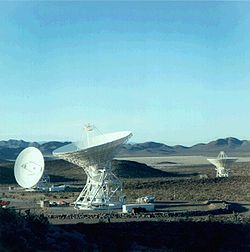- Goldstone Deep Space Communications Complex
-
Goldstone Deep Space Network 
Goldstone Deep Space NetworkOrganization NASA, JPL, Caltech Location Mojave Desert (near Barstow), San Bernardino County,
California, USACoordinatesEstablished Summer 1958 Website
http://deepspace.jpl.nasa.gov/dsn/TelescopesDSS 13 - "Venus"* 34m (~910 m²) reflector with Beam waveguide optics (BWG) on Alt/Az mount DSS 14 - "Mars" 70m (~3850 m²) reflector on Alt/Az mount DSS 15 - "Uranus" 34 m "High Efficiency" reflector on Alt/Az mount DSS 24, 25, 26 - "Apollo" 34 m reflector with BWG optics on Alt/Az mount DSS 27, 28 - "Gemini" 34 m reflector with BWG optics on "High Speed" Alt/Az mount Pioneer Deep Space Station Pioneer Deep Space Station
Pioneer Deep Space StationLocation: Goldstone Deep Space Communications Complex, Fort Irwin, California Coordinates: 35°23′21.41″N 116°51′22.31″W / 35.3892806°N 116.8561972°W Area: less than 1-acre (4,000 m2)[1] Built: 1958 Architect: U.S. Army Architectural style: No Style Listed Governing body: National Aeronautics & Space Administration NRHP Reference#: 85002813 Significant dates Added to NRHP: October 3, 1985[2] Designated NHL: October 3, 1985[3] The Goldstone Deep Space Communications Complex (GDSCC) — commonly called the Goldstone Observatory — is located in California's Mojave Desert. Operated by ITT Corporation for the Jet Propulsion Laboratory, its main purpose is to track and communicate with space missions. It includes the Pioneer Deep Space Station, which is a U.S. National Historic Landmark. The current observatory is part of NASA's Deep Space Network. The Goldstone Deep Space Communications Complex is one of just three in the world; the others being the Madrid Deep Space Communication Complex and the Canberra Deep Space Communication Complex.
Contents
Antennas
Goldstone antennas have also been used as sensitive radio telescopes for such scientific investigations as mapping quasars and other celestial radio sources; radar mapping planets, the Moon, comets and asteroids; spotting comets and asteroids with the potential to strike Earth; and the search for ultra-high energy neutrino interactions in the moon by using large-aperture radio antennas.[4]
"Goldstone has the bird"
It is commonly believed that the first U.S. satellite, Explorer I, was confirmed to be in orbit by the use of the phrase "Goldstone has the bird". However, Goldstone was not in operation at the time of Explorer I, and like many oft-repeated quotations it is a misquote. The actual phrase was "Gold has it!"[5] "Gold" was not an abbreviation of Goldstone, but code for a temporary tracking station at Earthquake Valley in the Anza-Borrego desert.
Commemoration
The Pioneer Deep Space Station was declared a National Historic Landmark in 1985.[1][3]
Complex tours
The Goldstone Deep Space Communications Complex conducts tours of its facility and museum to middle and high schools, as well as individuals interested in visiting.
See also
- List of radio telescopes
- Apollo 11 missing tapes
References
- ^ a b Harry A. Butowsky (May 15, 1984) (PDF). National Register of Historic Places Inventory-Nomination:. National Park Service. http://pdfhost.focus.nps.gov/docs/NHLS/Text/85002813.pdf. Retrieved 2009-06-22 and Accompanying three photos, from 1969, the 1970s, and 1983PDF (634 KB)
- ^ "National Register Information System". National Register of Historic Places. National Park Service. 2007-01-23. http://nrhp.focus.nps.gov/natreg/docs/All_Data.html.
- ^ a b "Apollo Deep Space Station". National Historic Landmark summary listing. National Park Service. http://tps.cr.nps.gov/nhl/detail.cfm?ResourceId=1930&ResourceType=Structure. Retrieved 2008-03-20.
- ^ "A Search for Ultra-High Energy Neutrino Interactions in the Moon Using Large-Aperture Radio Antennas". UCLA. http://www.physics.ucla.edu/~moonemp/public/. Retrieved 2008-03-28.
- ^ The First Explorer Satellites lecture by George H. Luwig, 9 Oct 2004
External links
- http://www.gdscc.nasa.gov/index.html
- Goldstone tours
- NASA's Deep Space Network
- JPL: Images of the Deep Space Network Goldstone, California
- JPL: Images of the Deep Space Network Goldstone, California
- JPL Communications Systems and Research Section 332 Website
- Historic 'Mars antenna' in Mojave Desert undergoing repairs (Los Angeles Times, October 3, 2010)
- Overview of World's Toughest Fixes episode about repair of 70 meter antenna
- http://www.gdscc.nasa.gov/index.html
NASA facilities NASA Headquarters
Research and test facilities: Ames Research Center · Dryden Flight Research Center · Glenn Research Center · Goddard Institute for Space Studies · Goddard Space Flight Center · Independent Verification and Validation Facility · Jet Propulsion Laboratory · Langley Research Center · Scientific Balloon Flight Facility · Stennis Space CenterConstruction and launch facilities: Johnson Space Center · Kennedy Space Center · Marshall Space Flight Center · Michoud Assembly Facility · Wallops Flight Facility · White Sands Test FacilityU.S. National Register of Historic Places Topics Lists by states Alabama • Alaska • Arizona • Arkansas • California • Colorado • Connecticut • Delaware • Florida • Georgia • Hawaii • Idaho • Illinois • Indiana • Iowa • Kansas • Kentucky • Louisiana • Maine • Maryland • Massachusetts • Michigan • Minnesota • Mississippi • Missouri • Montana • Nebraska • Nevada • New Hampshire • New Jersey • New Mexico • New York • North Carolina • North Dakota • Ohio • Oklahoma • Oregon • Pennsylvania • Rhode Island • South Carolina • South Dakota • Tennessee • Texas • Utah • Vermont • Virginia • Washington • West Virginia • Wisconsin • WyomingLists by territories Lists by associated states Other Categories:- Mojave Desert
- Deep Space Network
- Radio telescopes
- Astronomical observatories in California
- National Historic Landmarks in California
- Buildings and structures in San Bernardino County, California
- Museums in San Bernardino County, California
- Aerospace museums in California
- Science museums in California
Wikimedia Foundation. 2010.


